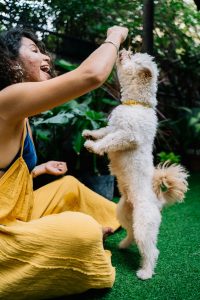Classical conditioning is one of the main techniques we use for dog training. It is part of obedience training and any positive reinforcement training. Basically, we present stimulus as something fun and good. In most cases, we combine classical conditioning with desensitization.
Let me give you a great example. Your dog doesn’t like little boys and skateboards. So, what we do? Whenever a skateboard passes by, you make sure your dog ignores it. How do you do that? By giving your dog treats when a skateboard passes by. This teaches your dog that good things happen when skateboards and little boys appear.
And by the time you finish giving off treats, the skateboard and little boy disappear. You ignore them when you see the stimulus and make sure your dog ignores them as well.
So, do you see it? It is such a simple way for training. But the challenge with classical conditioning is you have to be precise and on point. Often, people reward bad behavior instead of good behavior.
And then you are basically classically conditioning your dog to do bad stuff
Classical conditioning always wins.
How to make sure you do proper classical conditioning?
The whole point with classical conditioning as you can see is your dog gets treats (or food) for good behavior. Always use food, do not use treats. Why? Because food has nutrients. And for classical conditioning, you need lots of rewards.
You cannot give 200 treats in classical conditioning. You need to cut kibble into smaller parts and give it as a reward to your puppy.
Now, how to make sure your dog loves it? Well, you hand feed for a week. This teaches your puppy to like taking food from the hand. It teaches your pet that good things come from you. And food is something they naturally love because of their survival instinct.
How does food work in classical conditioning? You see your dog doing something you do not want, you call him come dog, let him sniff the treat, and give it to him. Come sit, come sit a couple of times, and he comes to you. This is how you improve your dog’s confidence and makes him want to come to you.
Difference between bribe and lure
We said before that you need a lot of food for classical conditioning. But there lies the challenge. Some dog owners do not make the difference between bribe and lure. With luring, your dog will come to you even when you do not have treats in your hand. If you bribe your dog, he will come only when he sees a treat.
And this is a big problem in dog training. People are using too much food and they are actually bribing their dogs. Instead of luring and rewarding, you are bribing by showing food again and often.
The problem is owners often try to accomplish something. They fail, and they instantly put food in hand. Magic happens, and the dog does it instantly. But we use it way too often and we bribe our puppies.
Here is the simple definition and distinction: “A bribe is shown as a promise beforehand to coerce an unwilling dog to do what you want”.
If you do this for a while, you will have a dog that will obey only when you have food in your hand.
How do classically condition works in dog training?
Classical conditioning always wins, but people get it wrong. They are either scared to reward the dog when he is barking, or they reward when he is barking for the wrong reason.
Barking can sometimes be good, but if you reward barking for the wrong reason, your dog will be confused. There is a right and wrong time to bark. For example, it is good to bark at intruders coming to your home, right?
There are two types of feedback you give when you classical condition training your dog. One is low-level praise. And one is high-level praise.
With classical conditioning, you need to have a threshold. And you need to do it under the threshold so that you do not get too close to the stimulus.
Let’s say a real-life situation. You walk with your dog, and you see another dog approaching. That is stimulus. Your dog is getting ready to react. Well, just shush your dog, and praise him in the presence of another dog. Or, change direction, move away, and then when your dog is calm, praise him.
The trick is to associate a negative stimulus with a positive reaction. If you shush and calm your dog, pet him, and praise him when there is another dog passing by, your dog associates it this way, “whenever a dog passes by and I do not bark, I get a treat”.
For example, teachers apply classical conditioning in the class by creating a positive classroom environment. This helps students overcome anxiety or fear. For example, they pair an anxiety-provoking situation like performing in front of a group, with pleasant surroundings. This helps the student learn new associations. It is the same with dogs.
And you can make a difference. Differential classical conditioning is when you give low praise when the stimulus is present and your dog reacts. And then give high praise if the stimulus is present but your dog doesn’t react.






